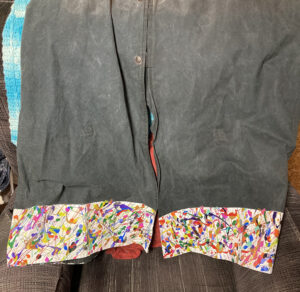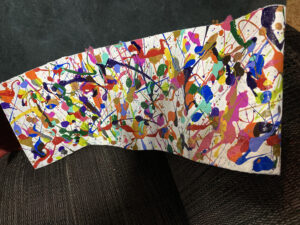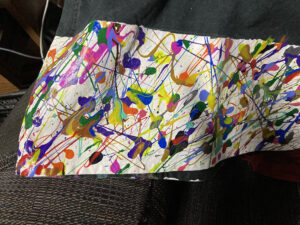The coat painting continues this week as I attempted some drip painting. So far in the saga of painting my new winter coat, a black duster, I have finished painting the back and front of the cape that drapes over the shoulders of the coat. The back has a complex image filled with lots of different faces and such and the from has two large eyes in decorative circles. That took a long time to do. Then I moved on.
At some point during the painting of the cape I decided I wanted to paint the bottom six inches of the coat. That and the first six inches of the sleeves (which I still haven’t done yet). I knew I wanted to paint some sort of design on the bottom of the coat but I didn’t have any idea what kind. I had an idea for some sort of geometric design but then it never really came together in my head. Instead I got the idea for a drip painting in the style of Jackson Pollock.
Pollock had a very specific way of working and there is a documentary movie where you can see him painting. He called his style/method “Drip Painting” and that is a very apt title. He didn’t throw or fling paint at a canvas he dripped it on. He would put a canvas on the floor of his studio, dip a stick of some sort into the paint, and then let the paint run off the stick onto the canvas as he moved the stick, and therefore the paint, all around the canvas. Despite the reputation of this method it is very controlled.
I haven’t done much drip painting but I remember testing it out a couple of times in the past just to see if I could get the paint to drip off a stick. It really does take a bit of practice and you have to have the paint at the right viscosity.
Before painting the bottom six inches of my coat I first had to measure out the bottom six inches. A long coat, such as the duster, doesn’t actually got all the way around the bottom in a single piece of fabric. The fabric spilts in the back, right down the middle, and there is a left and right side to the bottom of the coat. I isolated the bottom right side, measured off six inches, drew a line in white, ran an inch wide piece of tape along that line, and finally covered above and below that line with protective paper. Then I was ready to drip.
Almost. First I had to put down a layer of white paint over the black fabric. So I painted that. I bought a large jar of opaque white fabric paint a few days before just for this purpose. That was another $20 added to the coast of this coat. I think I’m up around $200 total for coat and paint.
I knew I was going to have a problem with the dripping part. The fabric paint that I was planning on using was from the cheaper $20 set of eighteen paints that come in these squeeze bottles that let out the paints in drops and globs as you squeezed them. The paint is thin compared to the fabric paint I bought in jars so I thought that they might be thin enough to drip out of the bottles. They weren’t.
I even tried putting a brush handle/stick into the paint but it was not thin enough to drip off. I think I needed a bigger stick dipped in more paint to get it to drip properly.
I had already spent a lot of time painting the back of the cape and didn’t want to spend a lot of time of the bottom of the coat so I knew I’d have to muddle through. This part of the coat was being painted purely as decoration anyway so I wasn’t looking to make a “Real” painting out of it. So muddle I did.
I grabbed one of the bottle of paint and started squeezing the paint out as I flung it around the bottom of the coat. I could get some strings of paint coming out of the bottle this way but it also made thick blobs of paint too. It came out sort of like a squeeze bottle of ketchup where you get one big blob of ketchup one your hamburger and then had to spread it around. But I couldn’t spread it around because that would ruin all the strings and drips.
Seeing those blobs of paint made me realize that I had underestimated the time it would take the paint to dry on this drip painting portion of the coat. It was water based paint which usually dries quickly but not when it’s in blobs. I painted the images on the cape with thin coats of paint. A coat would take about half an hour to dry. Often less time depending. But not these blobs.
It only took about half an hour of flinging paint out of sixteen different bottles (I didn’t fling the black or white bottles) to get the drip painting to where I wanted it to be. That went quickly. I figured it would be another few hours before the blobs of paint were dry but I was way off on that.
I was making the painting on top of my drawing table and I finished it around 3PM. I left it in place figuring it would take few hours to dry. 6PM rolled around and there was no sign of it drying. I wanted to free up my drawing table so I had to figure out a way to move the coat. I ended up sliding a 24×36 inch blank canvas underneath it and I then put that canvas onto the arms of a chair. I had my drawing table back.
I left the coat there and the next morning check it again. It was still not dry. That afternoon, 24 hours later, the blobs of paint were still mushy and not dry yet. It wasn’t until the following morning (Saturday) that the paint was dry enough to move around. I’m still not sure if it was all through and through dry but I could, at least, remove the tape and then paint the left side of the bottom of the coat. So that’s what I did.
It was Saturday morning that I drip/squeeze painted the other side and now it’s Sunday morning as I write this. The coat is again sitting on the canvas on the chair. It’s nowhere near dry just yet. I’ll have to wait until tomorrow morning for that. Now I have to contemplate what to do with the cuffs.


